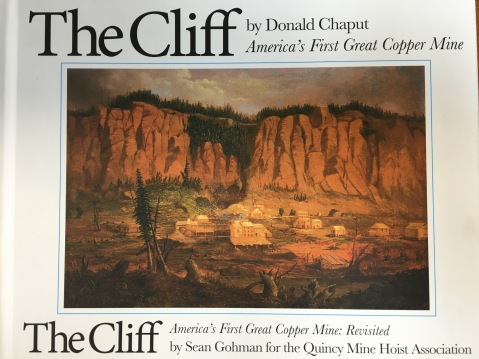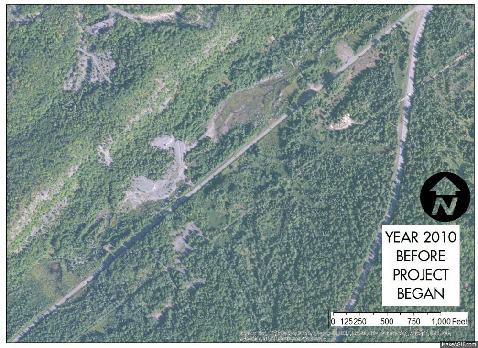Reissue of The Cliff: America’s First Great Copper Mine, now available. And a new blog.
This gallery contains 3 photos.
This is actually old news now but I realized I forgot to post something here. I don’t update this blog anymore, so it slipped my mind. If have set up a new personal blog, The Industrious Archaeologist blog at seanmgohman.com (that still covers/will cover a lot on Cliff) for anyone interested in following along. It’s […]
Visualizing the map in progress, 2010-2014
This gallery contains 1 photo.
The vast majority of data was collected in 2010 and 2012, as those were years where primary focus was on mapping Cliff and Clifton, respectively. In 2011, 2013, and this year, mapping is secondary, though what has been mapped has filled in the edges somewhat. The 2014 season is not over, and the focus is […]
What was (and is now) the ‘Function/Use’ of the Cliff?
So the property has a classification and (at some point) will have a hard number of contributing and non-contributing resources that go into that will help support its nomination… and in this next step, the assignment of past and current Functions/Uses. It’s important to list what a property’s current state of use (or function) in […]
The Classification of the Cliff Property
So now we’re getting into the nuts and bolts of the National Register Nomination forms. It’s the part of the process that is very important in terms of how the property will be viewed by potential owners/caretakers from now on. Again, this step in the process is seemingly simple and straightforward, but in reality it […]
Temporal Boundaries
So the physical boundaries of the Cliff Mine nominated property have been defined. But what of the time period of significance? This determination is important for considerations of future management, as well as refining the scope of possible narratives about the site useful for future funding (grants, for instance). For starters, a nominated property must […]
First Things First: Defining Boundaries
This gallery contains 2 photos.
For the majority of National Register nominated properties, defining a boundary isn’t too difficult. The historic home is defined by it’s lot (unless it’s just one of several historic homes—then perhaps the entire block/neighborhood). Same goes for most other architectural resources. But what of a landscape? Is it enough to only include a 100 year […]
What is the National Register of Historic Places?
As stated by the Guidelines for Completing National Register of Historic Places Forms, “The National Register of Historic Places is the official Federal list of districts, sites, buildings, structures, and objects significant in American history, architecture, archaeology, engineering, and culture. These [places] contribute to an understanding of the historical and cultural foundations of the nation.” These places include all prehistoric and historic properties of the National Park System, all National Historic Landmarks, and properties that have been successfully nominated for inclusion by State Historic Preservation Officers, Federal agencies, and even you.
To qualify for the National Register, a property must possess both historic significance and integrity. Significance is tied to “four aspects recognized by the National Register Criteria.”
- Criteria A: Association with historic events or activities.
- Criteria B: Association with important persons.
- Criteria C: Distinctive design or physical characteristics.
- Criteria D: Potential to provide important information about prehistory or history.
The first two criteria are fairly straightforward. The site of an important battle (or in our case, the first profitable copper mine in Michigan) is a great example of significance under Criteria A. The birthplace of an American President would be one example falling under Criteria B. Criteria C is often associated with architecture or perhaps (in the case of the Copper Country) a well preserved company town/district. But it can also refer to an excellent example of workmanship or technical practice not tied to a specific piece of architecture. For instance, one building may not be individually significant, but a collection of structures could embody a distinctive method of creation, use, or process. Criteria D is generally associated with archaeological resources. The property may not include any standing/obvious features at the surface, but beneath that surface may be found years and years worth of resources related to some aspect of our nation’s history and/or prehistory.
Beyond historic significance, a nominated property must also contain a level of integrity. This is defined as “the authenticity of a property’s historic identity, evidenced by the survival of physical characteristics that existed during the property’s prehistoric or historic period.” A property is measured against seven qualities that can determine historic integrity:
- Location
- Design
- Setting
- Materials
- Worksmanship
- Feeling
- Association
A property does not need to meet all seven qualities, but it must meet at least one.
As you continue following my education in completing one of these nominations, I’ll return to these ideas of historic significance and integrity, and discuss how the Cliff mine and Clifton meet (and in some cases, don’t meet) these Criteria and qualities.
Next time I’ll discuss the importance of defining appropriate boundaries for your nominated property.
The blog is back. Happy 2014!
Welcome back to the Cliff Mine Archaeology Project blog. I started this blog back in the spring of 2010 to follow research that formed the heart of my Master’s thesis. I continued working at Cliff for the next two summers, focusing on excavations at the mine’s stamp mill location. In 2012, additional student researchers joined […]
Check Out a Fellow Blogger’s Post on his recetn Visit to the Cliff.
Early in the field season I was contacted via email by Frank Hutton, a photographer and artist interested in the Lake Superior basin’s cultural and natural wonders. Frank has a blog running, “In Search of Perfect Light…,” and asked me if he could visit our workings and maybe write up a post on his visit. […]
What Happened to the Blog? Where are New Posts?
Sorry for the lapse in posting everyone. I’ve been pretty busy with things outside of Cliff research for the past month. First, I had to work on and finish a report for one of my funders. Second, I got married and there were TWO receptions in two different parts of the Midwest. I’ve therefore been […]






Recent Comments